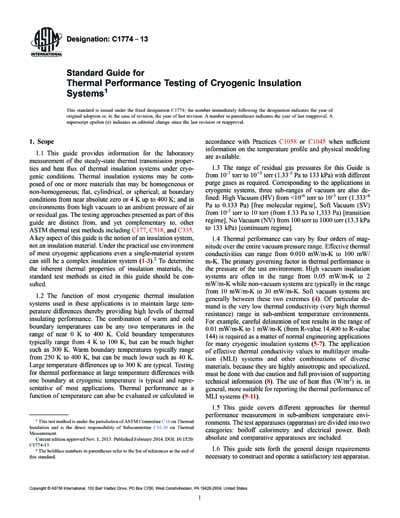Historical
ASTM C1774-13
Standard Guide for Thermal Performance Testing of Cryogenic Insulation Systems
1.1 This guide provides information for the laboratory measurement of the steady-state thermal transmission properties and heat flux of thermal insulation systems under cryogenic conditions. Thermal insulation systems may be composed of one or more materials that may be homogeneous or non-homogeneous; flat, cylindrical, or spherical; at boundary conditions from near absolute zero or 4 K up to 400 K; and in environments from high vacuum to an ambient pressure of air or residual gas. The testing approaches presented as part of this guide are distinct from, and yet complementary to, other ASTM thermal test methods including C177, C518, and C335. A key aspect of this guide is the notion of an insulation system, not an insulation material. Under the practical use environment of most cryogenic applications even a single-material system can still be a complex insulation system (1-3).2 To determine the inherent thermal properties of insulation materials, the standard test methods as cited in this guide should be consulted.
1.2 The function of most cryogenic thermal insulation systems used in these applications is to maintain large temperature differences thereby providing high levels of thermal insulating performance. The combination of warm and cold boundary temperatures can be any two temperatures in the range of near 0 K to 400 K. Cold boundary temperatures typically range from 4 K to 100 K, but can be much higher such as 300 K. Warm boundary temperatures typically range from 250 K to 400 K, but can be much lower such as 40 K. Large temperature differences up to 300 K are typical. Testing for thermal performance at large temperature differences with one boundary at cryogenic temperature is typical and representative of most applications. Thermal performance as a function of temperature can also be evaluated or calculated in accordance with Practices C1058 or C1045 when sufficient information on the temperature profile and physical modeling are available.
1.3 The range of residual gas pressures for this Guide is from 10-7 torr to 10+3 torr (1.33-5 Pa to 133 kPa) with different purge gases as required. Corresponding to the applications in cryogenic systems, three sub-ranges of vacuum are also defined: High Vacuum (HV) from <10-6 torr to 10-3 torr (1.333-4 Pa to 0.133 Pa) [free molecular regime], Soft Vacuum (SV) from 10-2 torr to 10 torr (from 1.33 Pa to 1,333 Pa) [transition regime], No Vacuum (NV) from 100 torr to 1000 torr (13.3 kPa to 133 kPa) [continuum regime].
Content Provider
ASTM International [astm]






